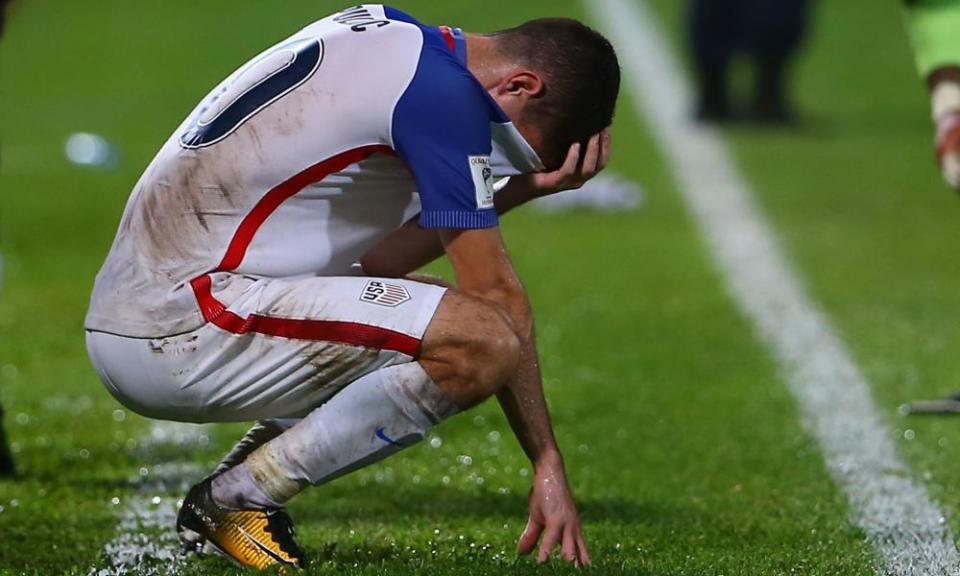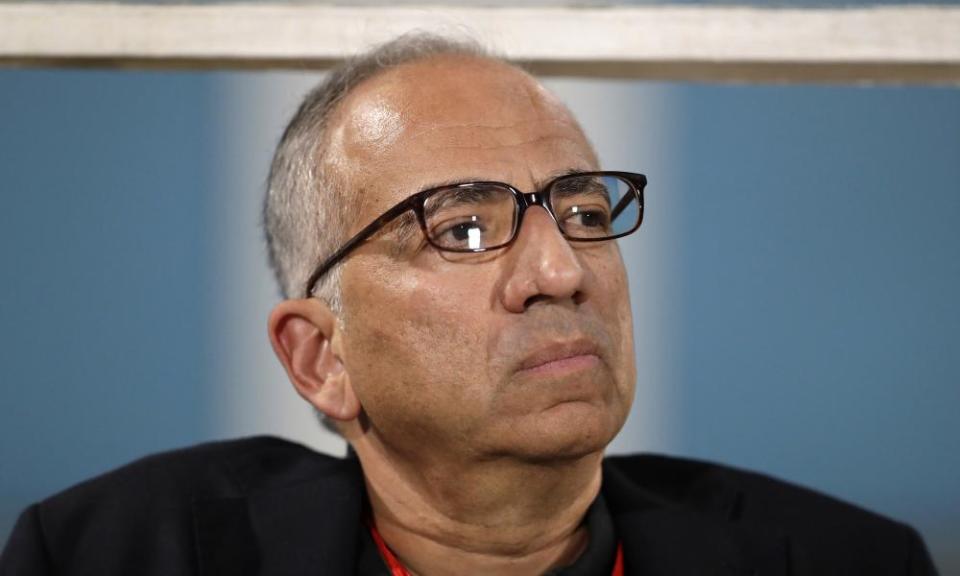After six months, is Carlos Cordeiro close to reviving US soccer fortunes?
The new US Soccer president helped bring the 2026 World Cup to North America, but problems from a new coach to infighting need to be addressed

When Carlos Cordeiro was elected US Soccer Federation (USSF) president, his mandate was to bring the 2026 World Cup to North America and to transform the federation’s governance.
But his critics fretted that he would merely effect incremental change, not the sweeping reforms they think are needed. For others he was an enigma, little-known beyond the USSF representatives who had elected him vice-president two years prior.
Six months into his reign, Cordeiro has done nothing to change anyone’s mind and, as the recent flap over declining youth participation rates shows, the US soccer community is still crying out for change.
“Carlos has had a huge early victory by securing the 2026 World Cup for the US and our neighbors, but to steal a soccer cliche, you just wonder if he’s scored too early,” says Kyle Martino, an NBC commentator and former national team player, who ran against Cordeiro for the presidency. “Coming off that high, the reality of the compounding youth soccer problems will definitely be sobering. There is no issue of consequence facing our soccer nation more alarming than the warring fiefdoms born out of the remarkable market confusion allowed, or even orchestrated, by USSF.”
In hindsight, it’s hard to imagine Cordeiro’s first six months going any differently. The first priority was the World Cup bid, which worried organizers enough that Cordeiro and others spent a couple of months globe-trotting for face-to-face meetings with as many voters as possible.
“For obvious reasons, that’s where Carlos’ focus has been,” says the US Club Soccer CEO, Kevin Payne.
His globetrotting, though, has given him a lower profile in the USA, especially in comparison with his garrulous and sometimes combative predecessor, Sunil Gulati. He also rarely spoke in public or with the media in his campaign, and he’s still a man of few words – he provided a couple of statements to the Guardian via email through a USSF spokesman for this story.
Cordeiro has actually plowed through several parts of his campaign platform beyond the World Cup bid. Under Cordeiro’s leadership, USSF hired Earnie Stewart as the men’s national team first-ever general manager, formed multiple new committees on the Board of Directors, and re-organized some of the federation’s staff duties.
The changes on the Board of Directors directly fulfilled some campaign promises. He pledged to create a technical committee, chaired by an athlete on the board. (It’ll actually have co-chairs, former national team players Carlos Bocanegra and Angela Hucles.) He also pledged a commercial committee, chaired by an independent director – in reality, this committee has no listed chair, but it does include independent director Val Ackerman. That group should provide a check and balance on the relationship between US Soccer and Major League Soccer affiliate Soccer United Marketing, a relationship seen by many reformers as too cozy and conflicted.
“I know board committees don’t sound exciting, but, believe me, we’re changing the way we run our federation,” Cordeiro said earlier this year. “We’ve restructured our senior management to align with the board and improve accountability.”
Perhaps such change is incremental, as his critics feared. But perhaps the heated US Soccer election yielded an inflated impression of what a president can do.
“He and his staff sealed the 2026 bid, so that is something,” says Lesle Gallimore, the longtime University of Washington women’s soccer coach and current president of United Soccer Coaches. “It may have very well have happened under Gulati, but it is still an accomplishment and he had a part in it.As far as any further reaching impact he’s had since he’s been in office, I think it’s too soon to tell.”
Cordeiro’s other accomplishments thus far are difficult to quantify. Take the men’s GM job. Stewart wasn’t a controversial hire. He grew up in the Netherlands and scored important goals for the USMNT, then went into management. The problem isn’t him; it’s the job.
“[Hiring Stewart] was a step in a good direction,” Payne says. “The question I still have is what is he the general manager of? Originally, they were describing the job pretty narrowly – management of the national teams. I’m hoping his responsibilities will go beyond that and that he’ll be responsible for helping to manage and create a coherent policy for everything on the technical operation.”
Other hiring has stalled. The timetable for hiring a women’s general manager isn’t known, though the team plays World Cup qualifiers in October. Longtime youth national team coach Tab Ramos fretted recently that several US youth teams have unfilled coaching positions. And there’s still no permanent men’s national team coach, even with several potential candidates becoming available at the end of the World Cup.

“The hiring of Earnie Stewart as USMNT GM was an important statement, although I think the time it’s taken to hire a permanent USMNT coach has been unnecessary,” says Alexi Lalas, a Fox Soccer commentator and also a former Stewart teammate.
Cordeiro addressed the men’s national team job, which Dave Sarachan has filled on an interim basis for nearly a year, in comments to the Guardian. “We do not have a specific timetable. We aren’t hiring a coach for the next four months; it’s for the next four years. ... Earnie only started on 1 August, which was days ago. He will lead the search which will include identifying and interviewing a shortlist of candidates.”
With the bid done, Cordeiro can turn his attention to other tasks. And the squeakiest wheel at the moment is youth soccer, where a survey showing plummeting participation rates (other numbers are less alarming, but even the most optimistic take shows the numbers are stagnant) has turned low-level concern into widespread panic, epitomized by a Los Angeles Times piece with the headline “Here’s how screwed up the state of US Soccer is right now.”
Coincidentally, just after the participation report was released, US Youth Soccer held its own annual general meeting, calling together the 55 state associations that comprise the organization (but not the competing national bodies – US Club Soccer, AYSO, SAY and USSSA – that have frequently feuded with each other). Two pieces of news emerged from that meeting:
First, Cordeiro called for a task force to bring together the various factions, like Don Corleone calling a meeting of the five families. The organizations formed their own “working group” in late 2015, but it was in response to heavy-handed mandates such as the controversial move to birth-year age groups, anecdotally cited as a factor in declining youth participation.
“We were talking about areas of common concern,” Payne says. “That was a good thing. I think people got discouraged. We kind of got nowhere with the federation. I think there was always some resistance to it because members themselves created it. It wasn’t created by the federation staff. It never seemed to be very accepted.”
So Cordeiro’s call for a new task force has to potential to reset the relationship between the youth organizations and the federation.
“The idea behind the Task Force is to bring all our youth member organizations together to look at the challenges we’re facing and see how we can improve,” Cordeiro wrote to the Guardian. “The specific areas of focus still need to be agreed, but topics such as the birth-year mandate and its effect would be something that could be open for discussion. Overall, we want to make sure that everything we put in place is helping us increase participation and develop players. In terms of the Development Academy, we are proud of its success but at the same time we know not every player will take, or should take, that path. There should be multiple pathways and we need to continue to refine and align all pathways so we’re positioned to identify the best talent in the future.”
The second piece of news drew less publicity but shows the complexities of USSF politics. Soon after his speech, US Youth Soccer ousted its incumbent chairman, Jesse Harrell, in favor of California trauma surgeon and longtime state association chairman Pete Zopfi.
Zopfi didn’t cite Cordeiro’s election as a factor in his decision to run. But Harrell may have paid a price for the US Youth Soccer board’s stunning decision to endorse Cordeiro at the USSF election, releasing a memo the night before the election when most people at the annual meeting had repaired to their hotel rooms or the bar.
“It didn’t seem it was a well organized discussion about who to endorse,” Zopfi says. “I think a lot of states figured, ‘Hey, we’re on our own.’”
But Zopfi is by no means a knee-jerk basher of the USSF election results. He welcomed the task force idea. “Right now, we’re just wasting so many resources competing with each other,” Zopfi said. “What I would hope is Carlos with his proposed task force is going to stimulate the organizations to work together.”
Alexi Lalas believes Cordeiro’s problems lie close to home. “For Cordeiro, the 2026 World Cup gave him a huge win, but that goodwill will fade fast,” Lalas says. “This next six months, we will find out what he’s really about. He may find that convincing FIFA members is much easier than convincing USSF members.”
And Cordeiro is working on all levels. Martino, now the chairman of grassroots organization Street Soccer USA, says he’s due to meet with his former political rival in September. He’ll also have to deal with the professional leagues as legal action rolls onward.
“His biggest and hardest challenge lies ahead,” Lalas says. “I think he will need to be seen as bringing true change to how USSF deals with things like pay to play, player registration, youth development, pro league sanctioning standards. SUM/MLS relationship and governance structure. As Janet Jackson said, ‘What have you done for me lately?’”
And after spending so much of his first six months circling the globe to ensure a win in the 2026 World Cup vote, Cordeiro is still in a honeymoon phase. That’s just about over.
“I think the real first six months for him comes now, not prior to now,” Zopfi says.

